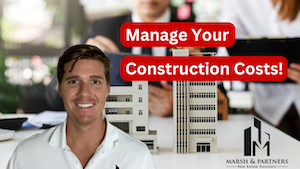What Goes Into Pre-development for a Commercial Real Estate Project?
Pre-development is a loaded term - everything that's required before you can break ground on a project is considered pre-development.
So, there's a lot to consider. And how you manage project design and the critical components of the pre-development process play a direct role in the future success of a project.
The video below offers developers, investors, and business owners a look into what needs to be considered during pre-development and why it's important.
Guide to the video
- Pre-development is an iterative process. Each step of the site and building design process compounds on itself with more detail
- Since most of the planning happens before construction, it's critical that project owners manage land entitlement to ensure the project is adequately permitted
- A building's design has a direct impact on its costs - in order to properly manage the construction budget you need to value engineer a property's design during pre-development
Video transcript follows
When you drive down the street you probably see a lot of real estate – some residential and some commercial. But all you’re likely seeing is the end product, which could be an office building or a strip mall or an apartment complex. But there’s a ton of work that goes into a commercial real estate project before it gets to that point.
Most anyone that’s developed property understands that the most challenging aspect of any project is getting it to the point where it’s shovel-ready. Once you break ground, there will inevitably be hiccups, but the bulk of any land entitlement risks or political pushback has largely already been dealt with.
But what does it take to get a real estate development project to that point? That can generally be described as pre-development and includes a lot of the feasibility, real estate due diligence, and planning work required to get a project approved and permitted.
So, in this video, I am going to dive into the pre-development process for a commercial real estate project. I’m going to cover everything that you, as a real estate developer, need to know to set your construction project up for success.
What’s up everyone – it’s Matt Marsh with Marsh & Partners.
Marsh & Partners is a development and national consulting firm that helps business owners and investors maximize their real estate and transform their businesses.
If you’re enjoying what we’re doing here, and want to keep seeing more content like this, please hit that like button and share this video and our other videos with people you think might find some value in it.
What is real estate pre-development? Where does it fit into the overall process?
When I discuss the real estate development process, I like to break it down into its component parts:
- Site selection & land acquisition
- Pre-development
- Development/construction
- Post-construction & project closeout
So, really once the project site is identified during the site selection process, everything that follows until you begin construction can be considered pre-development.
Pre-development is an iterative process. First, developers will draft a site sketch for a property that offers a conceptual representation of how the site will be developed. From there the concept is solidified – grading, utility, and stormwater plans are firmed up and prepared for site plan submittal. Once a site plan is submitted it will go through several rounds of review before approval.
Simultaneously, building design is fleshed out. An architect will start with schematic design that details the initial site and interior building programming. As the floorplan and building elements are decided, the design team will further the architecture through design development and ultimately construction drawings that serve as the roadmap for the physical construction of a building.
So, all that happens during pre-development before you can break ground and move forward with any land development.
What to consider during pre-development
As I already briefly touched on, the pre-development phase is when a majority of the project planning happens. After you find a site, you need to assess whether it’s feasible for the project or not. A real estate development feasibility study is a good place to start and considers things like demographic and market data, construction costs (including hard and soft costs), competitor data, and anything else that could impact the viability of a commercial real estate project.
All of the due diligence work will need to be done before you break ground as well. Properly sequencing those real estate due diligence activities is critical to managing pre-development risk and ultimately setting a project up for success.
And most importantly, all your required land entitlement and permitting activities need to be completed during pre-development as well. Managing land entitlement risks throughout a commercial real estate project can be a huge challenge, and as a developer, you’ll need to consider how the municipality’s zoning laws, unified development ordinance (UDO), and design rules may impact your project.
If the property requires a rezoning, you’ll need to navigate that process in conjunction with the site plan approval process during pre-development.
Now, every municipality has its own unique quirks and set of permits you’ll need to obtain based on your specific project, but common permits and approvals to consider are:
- Erosion control and stormwater
- Site plan approval
- Driveway permits
- Utility connection permits
- Septic and well permits
- Grading / land disturbance permit
- Flood permits
- Stream / wetland impact permits
- Lighting permits
- Building permits
This isn’t an exhaustive list, but gives you a good idea of some of the approvals you need to consider during the pre-development phase of a commercial real estate project.
Most municipalities offer a pre-submittal or pre-application meeting that allows developers the opportunity to present an initial development concept for a property. That is a good chance to get a better idea about the commercial real estate development process as a whole, but also to ask individual planning and staff members about specific permitting and approval requirements for development concept.
Because the last thing you want during a project is to be caught blindsided by the process, causing project delays and racking up unnecessary carrying costs.
Why is the pre-development phase so important?
A project’s design dictates how it’s constructed, which ultimately informs price. It’s often said that the most important measure you can take to manage a project’s costs starts with how well you can control its design.
So, all of the design work, both engineering site design and architectural programming will impact how much the development costs and the financial feasibility of the deal.
For instance, an elaborately designed building may require more expensive materials or higher quality labor. If the pre-development process isn’t meticulously planned and the project lacks a clear vision and direction from the start, you may be in for an unfortunate surprise when you put a project out for bid.
Additionally, during pre-development it’s critical you assemble the right development team. That starts with the civil engineer but includes your architectural and design team, contractor, and other outside consultants that may need to assist with the project.
It’s worth considering how those different trades are managed during this phase of a development project. Before you break ground on a commercial real estate property, you’ll have to decide how you want to contract with the design and construction entities.
Traditionally, project owners have used the competitive or “hard” bid method of construction delivery. In that process, a project is designed up front, and the owner sends the construction documents out to several contractors to bid on the project. But that puts owners in a situation where only what is depicted on the architectural drawings is priced. The building is designed in a vacuum and there isn’t any real time pricing or design feedback from the construction team that might have some unique insights into value engineering the project.
Alternative methods of construction delivery like design-build or design-assisted get a contractor involved in the project much earlier and can lead to a more efficient and cost-effective pre-development process.
So as a real estate developer or small business owner, you’ll want to consider how you’ll manage the different entities in a project and when you bring them in to consult during pre-development.
Key takeaways
If you took anything from this video, it should be that there’s a lot to consider during pre-development, and it all needs to be worked out before you can begin construction. A project’s design has a direct impact on its costs and its development.
Before you get too deep into a project, it’s important to understand the entire approval process so you can direct the various service providers' efforts to work within the parameters the municipality lays out.
Pre-development is also the developer or business owner's opportunity to really craft their vision through design and the development of the project's concept.
----------
If you’re engaged in a real estate development project currently, or are thinking about tackling a project, we have a bunch of great articles and videos to help you through pre-development that are worth checking out.
Check out the video description for a link to our complete real estate development made simple guide and other great resources.
If you enjoyed this video hit the like button and subscribe to our channel to stay up to date on content to help you through your real estate journey.
You can also check out our site for more real estate insights at marsh-partners.com.
Feel free to leave us a comment if there are any other topics you’re interested in or would like us to cover.
Don’t forget to subscribe if you want more content like this and thanks for watching.



